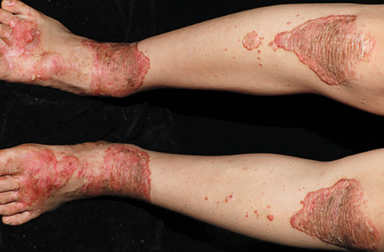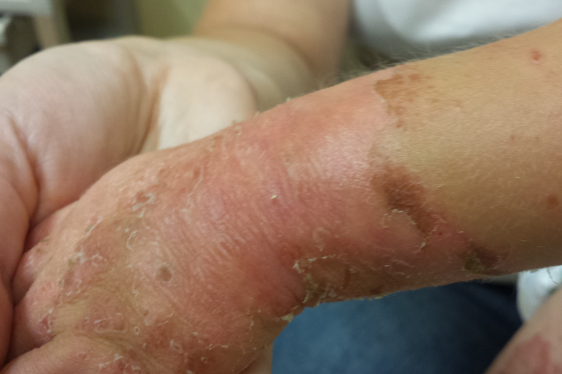Acrodermatitis Enteropathica (Danbolt-Closs Syndrome) is a systemic disease that occurs in children and sometimes adults due to zinc deficiency in the body. It is characterized by vesiculobullous eruptions, gastrointestinal disorders, and alopecia. ICD-10 Code: E60.
Zinc has been shown to play an important regulatory role in the body. Its deficiency leads to a decrease in enzymatic activity and nucleic acid synthesis, disruption of tryptophan metabolism, and suppression of cellular and humoral immunity. The cause of impaired zinc absorption is the absence of zinc-binding factor in breast milk. In biopsies of the intestinal mucosa, histological and histochemical methods have revealed a decrease in the enzymatic activity of succinate dehydrogenase and leucine aminopeptidase, as well as pronounced changes in the ultrastructure of Paneth cells (enterocytes with acidophilic granules), including homogenization of the cytoplasm, formation of giant granules and inclusions. The activity of serum alkaline phosphatase, which contains zinc in its structure, is decreased. It has been found that zinc efflux from fibroblasts of patients with enteropathic acrodermatitis is not impaired, but its binding to the cell surface and penetration into the cell is hindered. Zinc levels in fibroblasts from patients were found to be 62% lower than normal. Similar zinc attraction to membranes was observed, but the rate and extent of zinc penetration into the cell is 38% lower in patients.
Zinc deficiency is associated with growth retardation and underdevelopment of the male reproductive organs, skin lesions including perioral, perianal, and acral dermatitis, as well as the presence of dandruff, acne, and various forms of diaper rash. Other symptoms include decreased appetite, sluggishness, lethargy, slow wound healing, neurosensory and immune cell dysfunction.
By stimulating T cells with phytohemagglutinin for 24-72 hours, a transferrin receptor has been identified that is capable of binding zinc and stimulating DNA synthesis in preactivated and activated T lymphocytes. Such stimulation has been shown to increase nuclear protein levels from 5% to 40%. An optimal concentration of zinc salts (0.1-4.0 mM) that induces a mitogenic reaction in resting cells has been determined. Higher concentrations were toxic. These results explain the role and influence of zinc on the immune activity of cells in patients with enteropathic acrodermatitis. Zinc absorption in patients ranged from 16% to 30%, while absorption rates in control samples ranged from 58% to 77%. After receiving high doses of zinc aspartate (400 mg twice daily), all clinical symptoms disappeared within one week.
The disease is inherited. Consanguineous marriages occur in 25% of cases. Relatives of affected individuals often have decreased zinc levels, although this is not sufficient to identify heterozygotes. Low zinc levels may be seen with dietary zinc deficiency, prolonged parenteral nutrition, inflammatory gastrointestinal disease, and alcoholic cirrhosis.The disease may occur in the first days of life, as well as at 1.5-2 years of age, and in some cases may affect older children and adults. Cutaneous manifestations may develop simultaneously with, precede, or follow gastrointestinal disturbances. Sometimes the gastrointestinal disturbances are mild or present only in the early years of the disease. The skin shows erythematous and edematous lesions with vesicles, bullae, and pustules, usually localized around natural orifices, on the hands and feet, buttocks, groin, and genital areas. The eruptions are typically symmetrical, sharp-edged, and irregular in shape and often present as paronychia on the hands and feet. They may later spread to the knees and elbows. Frequently, the lesions merge into extensive areas with oozing, seropurulent crusts, resembling the clinical picture of eczema, psoriasis, bullous epidermolysis, or candidiasis. Vegetations may develop in skin folds. During the inactive phase, significant desquamation of the affected areas is observed. Hyperkeratotic plaques may resemble verrucous lesions. Mucous membranes are often involved with cheilitis, stomatitis, conjunctivitis, blepharitis with photophobia, glossitis, and vulvitis. Ectropion and delayed dental development are possible. One of the characteristic features of the disease is impairment of hair growth on the scalp, eyebrows, and eyelashes, resulting in thinning, sparseness, and even total loss. Nails show longitudinal and transverse striation and onycholysis. Some patients may experience psychological disturbances.
An important symptom of enteropathic acrodermatitis is gastrointestinal disturbances, including loss of appetite, abdominal distension, frequent watery stools with mucus, undigested food, and unpleasant odor. The general condition of patients worsens, and they may experience subfebrile temperature or fever of an irregular type. The progression of the pathological process is accompanied by delayed development, growth retardation and weight loss in children. Irritability, restlessness and lethargy appear, followed by apathy and depression. The course of the disease is severe, with exacerbations and remissions. During puberty, the course of the disease may become milder, although exacerbations are still possible. Without treatment, the disease often progresses and is complicated by bacterial and candidal infections, ultimately leading to a fatal outcome.
- Hailey–Hailey disease.
- Blisters occur as a result of traumatic impact.
- Inflammatory changes are secondary.
- Diarrhea is absent.
- Eczema
- It is characterized by microvesiculation and intense pruritus.
- Blisters, diarrhea, and alopecia are absent.
- Psoriasis
- Typical psoriatic lesions (i.e., erythematous papules and plaques with thick scales)
- The Auspitz sign is positive.
- It rarely develops in infants.
- It is not associated with diarrhea or alopecia.
- Bullous reactions are absent.
- Erosions are absent.
- Atopic dermatitis
- The diaper area is usually unaffected.
- Trunk involvement in children commonly.
- Common face involvement (e.g. cheeks), but rare involvement of the perioral and periorbital areas.
- It is usually associated with pruritus.
- Impetigo
- The eruptions are represented by erosions with yellow crusts.
- Erythematous patches are usually absent.
- Diaper dermatitis. The eruptions are confined to the diaper area.
- Seborrheic dermatitis
- Often the scalp is involved (e.g., cradle cap).
- Skin eruptions are often covered with "greasy" scales.
- Perioral and periorbital lesions are rare.
- Erosions are absent.
Zinc oxide is prescribed at a dose of 0.03-0.15 grams per day depending on age. In severe cases and when treatment is ineffective, the doses may be increased. Enteroseptol has a positive effect, but its use is rare due to its high toxicity. Once clinical recovery is achieved, the zinc dose is reduced to a maintenance dose, which is individualized and may be very low (8 mg). The duration of maintenance therapy is determined on a case-by-case basis. There is evidence that treatment should not be stopped until the onset of puberty, as premature discontinuation may lead to rapid relapse. Symptoms such as dry skin, scaly patches resembling seborrhea, and acneiform eruptions may indicate a decrease in zinc levels. It is believed that hair color changes before a flare-up: it becomes reddish and falls out.
It is important to monitor blood zinc levels during treatment with zinc preparations, especially during pregnancy, as intoxication may occur. Oral contraceptives may reduce zinc levels, which should be considered in maintenance therapy. The zinc dose may be reduced in patients who consume foods rich in zinc (meat, fish, eggs, milk). Coadministration of copper supplements is necessary when zinc is used because of the negative effect of zinc on copper metabolism. Immunostimulants are indicated to correct immune dysfunction and increase the patient's susceptibility to infection.
Medications that improve pancreatic function, such as pancreatin (panzinorm 10,000), could be effective.(Not evidence based. Need more investigations)
Genetic counseling is required. The risk of having a second child with clinically healthy parents is 25%. Children can be clinically healthy if their father (or mother) is healthy and not a carrier of the pathological gene, but they will inherit the gene responsible for the development of the disease. All children are affected if both parents have enteropathic acrodermatitis. In the case of a marriage between an affected person and a heterozygous carrier, half of the children will be affected, while the other half will be carriers of the pathological gene.


